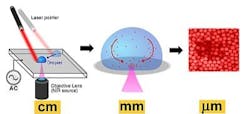'Lab-on-chip' mixes red laser and electric fields to manipulate fluids, particles
Researchers at Purdue University (West Lafayette, IN) are developing a method that combines a red laser and electric fields to manipulate fluids and tiny particles such as bacteria, viruses and DNA for applications such as drug manufacturing and food safety. The method could eliminate the need for costly, large laboratory equipment that performs the same types of measurements, says Steven T. Wereley, a Purdue University professor of mechanical engineering.
The "hybrid optoelectric manipulation in microfluidics" methodâwhich is promising for medical diagnostics, testing food and water, crime-scene forensics, and pharmaceutical manufacturingâuses a red laser to position a droplet on a special platform fabricated by Purdue. Next, a highly focused infrared laser is used to heat the droplets, and then electric fields cause the heated liquid to circulate in a "microfluidic vortex." This vortex is used to isolate specific types of particles in the circulating liquid, acting as a micro centrifuge. Particle concentrations replicate the size, location and shape of the infrared laser pattern. Wereley notes that it takes less than a second for particles to respond and get pulled out of solution.
Systems using the hybrid optoelectric approach can be designed to precisely detect, manipulate and screen certain types of bacteria, including particular strains that render heavy metals less toxic.
"We are shooting for biological applications, such as groundwater remediation," says Wereley. "Even within the same strain of bacteria some are good at the task and some are not, and this technology makes it possible to efficiently cull those bacteria from others. The bacteria could be injected into the contaminated ground. You seed the ground with the bacteria, but first you need to find an economical way to separate it."
The researchers also are pursuing the technology for pharmaceutical manufacturing, says Werely. "These types of technology are good at being very dynamic, which means you can decide in real time to grab all particles of one size or one type and put them somewhere. This is important for the field of pharmacy because a number of drugs are manufactured from solid particles suspended in liquid. The particles have to be collected and separated from the liquid."
Because centrifuges currently in use create a force on every particle, it has not been possible to specifically isolate certain particlesâuntil now. "We can, say, collect all the particles that are 1 µm in diameter or get rid of anything bigger than 2 µm, so you can dynamically select which particles you want to keep," says Wereley.
The technology also may be used as a tool for nanomanufacturing because it shows promise for the assembly of suspended particles, known as colloids. The ability to construct objects with colloids makes it possible to create structures with particular mechanical and thermal characteristics to manufacture electronic devices and tiny mechanical parts. The nanomanufacturing applications are at least five years away, says Wereley.
The technology also can be used to learn fundamental electrokinetic forces of molecules and biological structures, which is difficult to do with existing technologies.
An article about the hybrid optoelectric approach was published on July 7 in Lab on a Chip magazine, a Royal Society of Chemistry publication.
-----
Posted by Lee Mather
Follow us on Twitter, 'like' us on Facebook, and join our group on LinkedIn
Follow OptoIQ on your iPhone; download the free app here.
Subscribe now to BioOptics World magazine; it's free!

